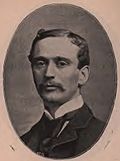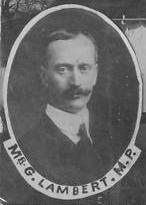| South Molton | |
|---|---|
| Former county constituency for the House of Commons | |
| 1885–1950 | |
| Seats | one |
| Created from | North Devon |
| Replaced by | Torrington and North Devon |
South Molton was a parliamentary constituency centred on the small town of South Molton in Devon, in the South West of England. It returned one Member of Parliament (MP) to the House of Commons of the Parliament of the United Kingdom.
The constituency was created for the 1885 general election, and abolished for the 1950 general election, when it was largely replaced by Torrington.
Boundaries
1885–1918: The Municipal Borough of South Molton, and the Sessional Divisions of Crediton, Great Torrington, and South Molton.
1918–1950: The Municipal Boroughs of Great Torrington, Okehampton, and South Molton, the Urban District of Crediton, and the Rural Districts of Crediton, Okehampton, South Molton, and Torrington.
Members of Parliament

| Election | Member | Party | |
|---|---|---|---|
| 1885 | Newton Wallop | Liberal | |
| 1886 | Liberal Unionist | ||
| 1891 | George Lambert | Liberal | |
| 1924 | Cedric Drewe | Unionist | |
| 1929 | George Lambert | Liberal | |
| 1931 | Liberal National | ||
| 1945 | George Lambert jnr. | National Liberal | |
| 1950 | constituency abolished | ||
Election results
Elections in the 1880s
| Party | Candidate | Votes | % | ±% | |
|---|---|---|---|---|---|
| Liberal | Newton Wallop | 4,925 | 62.7 | ||
| Conservative | Walter Rodolph Trefusis | 2,924 | 37.3 | ||
| Majority | 2,001 | 25.4 | |||
| Turnout | 7,849 | 84.0 | |||
| Registered electors | 9,343 | ||||
| Liberal win (new seat) | |||||
| Party | Candidate | Votes | % | ±% | |
|---|---|---|---|---|---|
| Liberal Unionist | Newton Wallop | 4,041 | 63.2 | +25.9 | |
| Liberal | William Heap Walker | 2,352 | 36.8 | −25.9 | |
| Majority | 1,689 | 26.4 | N/A | ||
| Turnout | 6,393 | 68.4 | −15.6 | ||
| Registered electors | 9,343 | ||||
| Liberal Unionist gain from Liberal | Swing | +25.9 | |||
Elections in the 1890s
Viscount Lymington was elevated to the peerage, becoming Earl of Portsmouth, causing a by-election.
| Party | Candidate | Votes | % | ±% | |
|---|---|---|---|---|---|
| Liberal | George Lambert | 4,222 | 58.4 | +21.6 | |
| Liberal Unionist | Charles William Buller | 3,010 | 41.6 | −21.6 | |
| Majority | 1,212 | 16.8 | N/A | ||
| Turnout | 7,232 | 83.0 | +14.6 | ||
| Registered electors | 8,712 | ||||
| Liberal gain from Liberal Unionist | Swing | +21.6 | |||
| Party | Candidate | Votes | % | ±% | |
|---|---|---|---|---|---|
| Liberal | George Lambert | 4,278 | 59.3 | +22.5 | |
| Conservative | Richard Moore-Stevens | 2,939 | 40.7 | −22.5 | |
| Majority | 1,339 | 18.6 | N/A | ||
| Turnout | 7,217 | 82.6 | +14.2 | ||
| Registered electors | 8,737 | ||||
| Liberal gain from Liberal Unionist | Swing | +22.5 | |||
| Party | Candidate | Votes | % | ±% | |
|---|---|---|---|---|---|
| Liberal | George Lambert | 4,283 | 59.4 | +0.1 | |
| Liberal Unionist | James J. Long | 2,923 | 40.6 | −0.1 | |
| Majority | 1,360 | 18.8 | +0.2 | ||
| Turnout | 7,206 | 83.2 | +0.6 | ||
| Registered electors | 8,662 | ||||
| Liberal hold | Swing | +0.1 | |||
Elections in the 1900s
| Party | Candidate | Votes | % | ±% | |
|---|---|---|---|---|---|
| Liberal | George Lambert | Unopposed | |||
| Liberal hold | |||||
| Party | Candidate | Votes | % | ±% | |
|---|---|---|---|---|---|
| Liberal | George Lambert | Unopposed | |||
| Liberal hold | |||||
Elections in the 1910s

| Party | Candidate | Votes | % | ±% | |
|---|---|---|---|---|---|
| Liberal | George Lambert | 4,419 | 56.5 | N/A | |
| Liberal Unionist | John Perowne | 3,398 | 43.5 | New | |
| Majority | 1,021 | 13.0 | N/A | ||
| Turnout | 7,817 | 89.9 | N/A | ||
| Registered electors | 8,700 | ||||
| Liberal hold | Swing | N/A | |||
| Party | Candidate | Votes | % | ±% | |
|---|---|---|---|---|---|
| Liberal | George Lambert | 4,224 | 56.8 | +0.3 | |
| Liberal Unionist | John Perowne | 3,217 | 43.2 | −0.3 | |
| Majority | 1,007 | 13.6 | +0.6 | ||
| Turnout | 7,441 | 85.5 | −4.4 | ||
| Registered electors | 8,700 | ||||
| Liberal hold | Swing | +0.3 | |||
General Election 1914–15: Another General Election was required to take place before the end of 1915. The political parties had been making preparations for an election to take place from 1914 and by the end of this year, the following candidates had been selected;
- Liberal: George Lambert,
- Conservative:

| Party | Candidate | Votes | % | ±% | |
|---|---|---|---|---|---|
| Liberal | George Lambert | 10,424 | 56.3 | −0.5 | |
| C | Unionist | Herbert Sparkes | 8,093 | 43.7 | +0.5 |
| Majority | 2,331 | 12.6 | −1.0 | ||
| Turnout | 18,517 | 65.8 | −19.7 | ||
| Liberal hold | Swing | −0.5 | |||
| C indicates candidate endorsed by the coalition government. | |||||
Elections in the 1920s
| Party | Candidate | Votes | % | ±% | |
|---|---|---|---|---|---|
| Liberal | George Lambert | Unopposed | N/A | N/A | |
| Liberal hold | |||||
| Party | Candidate | Votes | % | ±% | |
|---|---|---|---|---|---|
| Liberal | George Lambert | Unopposed | N/A | N/A | |
| Liberal hold | |||||
| Party | Candidate | Votes | % | ±% | |
|---|---|---|---|---|---|
| Unionist | Cedric Drewe | 12,811 | 51.3 | New | |
| Liberal | George Lambert | 12,157 | 48.7 | N/A | |
| Majority | 654 | 2.6 | N/A | ||
| Turnout | 24,968 | 85.3 | N/A | ||
| Unionist gain from Liberal | Swing | ||||
| Party | Candidate | Votes | % | ±% | |
|---|---|---|---|---|---|
| Liberal | George Lambert | 15,072 | 48.1 | −0.6 | |
| Unionist | Cedric Drewe | 13,567 | 43.2 | −8.1 | |
| Labour | Rudolph Putnam Messel | 2,731 | 8.7 | New | |
| Majority | 1,505 | 4.9 | N/A | ||
| Turnout | 31,370 | 87.4 | +2.1 | ||
| Liberal gain from Unionist | Swing | +3.8 | |||
Elections in the 1930s
| Party | Candidate | Votes | % | ±% | |
|---|---|---|---|---|---|
| National Liberal | George Lambert | 25,700 | 88.0 | +39.9 | |
| Labour | Rudolph Putnam Messel | 3,499 | 12.0 | +3.3 | |
| Majority | 22,201 | 76.0 | +71.1 | ||
| Turnout | 29,199 | 81.0 | −6.4 | ||
| National Liberal hold | Swing | ||||
| Party | Candidate | Votes | % | ±% | |
|---|---|---|---|---|---|
| National Liberal | George Lambert | 20,767 | 78.7 | −9.3 | |
| Labour | H F Chilcott | 5,610 | 21.3 | +9.3 | |
| Majority | 15,157 | 57.4 | −12.6 | ||
| Turnout | 26,377 | 72.9 | −8.1 | ||
| National Liberal hold | Swing | ||||
Elections in the 1940s
General Election 1939–40: Another General Election was required to take place before the end of 1940. The political parties had been making preparations for an election to take place from 1939 and by the end of this year, the following candidates had been selected;
- Liberal National: George Lambert
| Party | Candidate | Votes | % | ±% | |
|---|---|---|---|---|---|
| National Liberal | George Lambert | 19,065 | 67.6 | −11.1 | |
| Labour | C Lang | 9,140 | 32.4 | +11.1 | |
| Majority | 9,925 | 35.2 | −22.2 | ||
| Turnout | 28,205 | 71.9 | −1.0 | ||
| National Liberal hold | Swing | ||||
References
- Notes
- ^ Craig, FWS, ed. (1974). British Parliamentary Election Results: 1885-1918. London: Macmillan Press. p. 258. ISBN 9781349022984.
- "The General Election". Oxford Journal. 12 December 1885. p. 6. Retrieved 11 December 2017 – via British Newspaper Archive.
- "Nomination Day". North Devon Journal. 8 July 1886. p. 3. Retrieved 11 December 2017 – via British Newspaper Archive.
- Lambert, Sophia. "8. George Lambert M.P. (George IV) 1866-1958 AND FAMILY". Retrieved 19 November 2017.
- "Nominations for South Molton". Kirkintilloch Herald. 11 November 1891. p. 6. Retrieved 22 November 2017.
- "South Molton Division". Western Morning News. 22 July 1895. p. 8. Retrieved 22 November 2017.
- Sources
- Craig, F. W. S. (1983). British parliamentary election results 1918-1949 (3 ed.). Chichester: Parliamentary Research Services. ISBN 0-900178-06-X.
- Leigh Rayment's Historical List of MPs – Constituencies beginning with "S" (part 4)